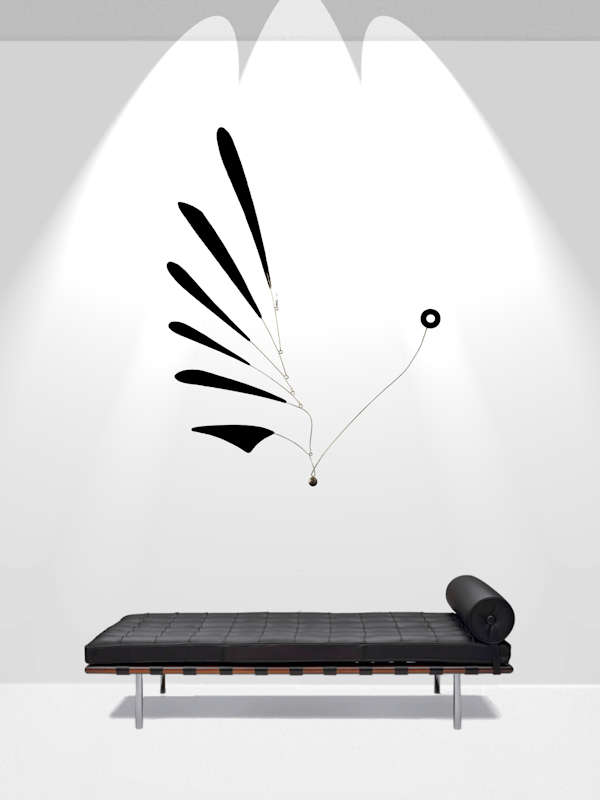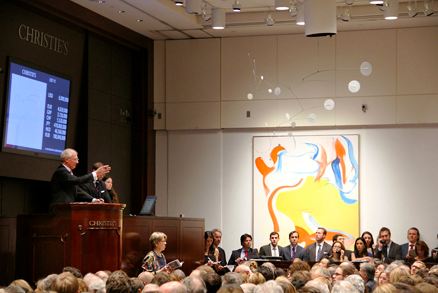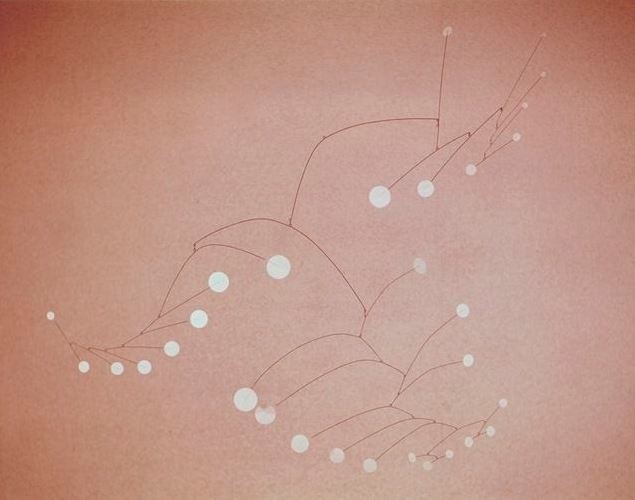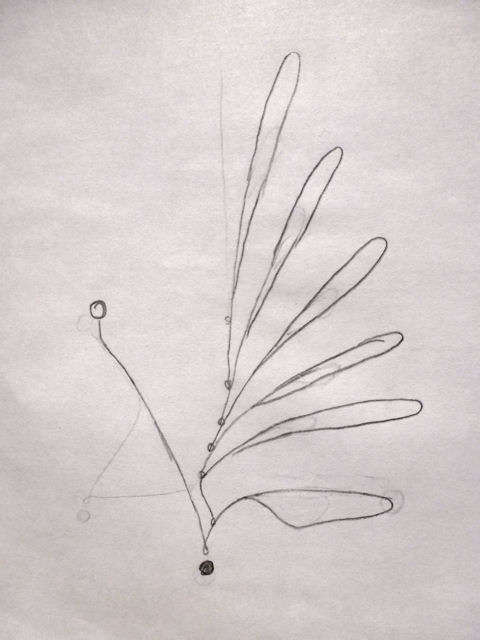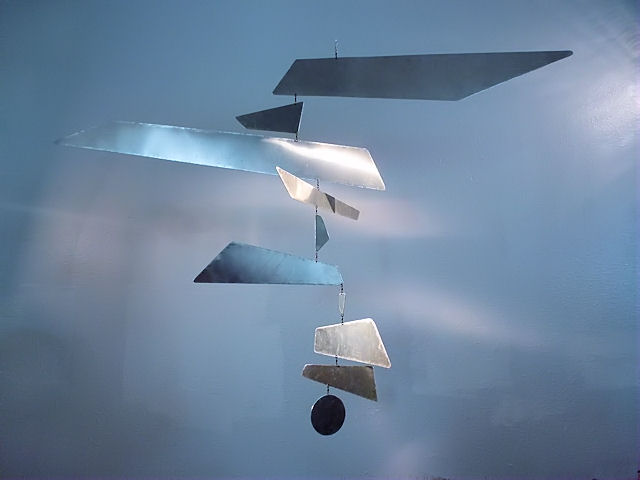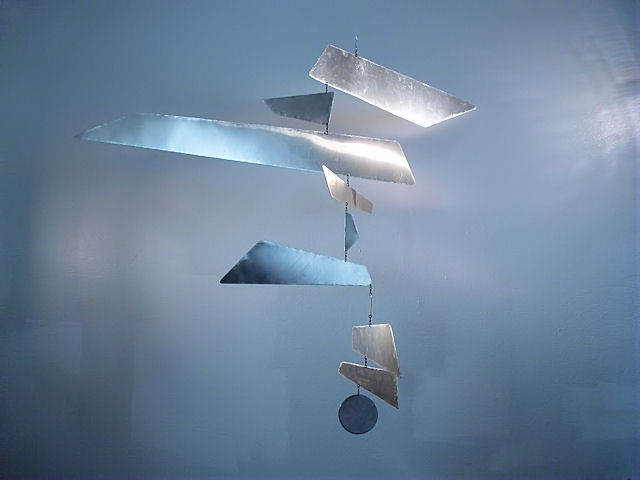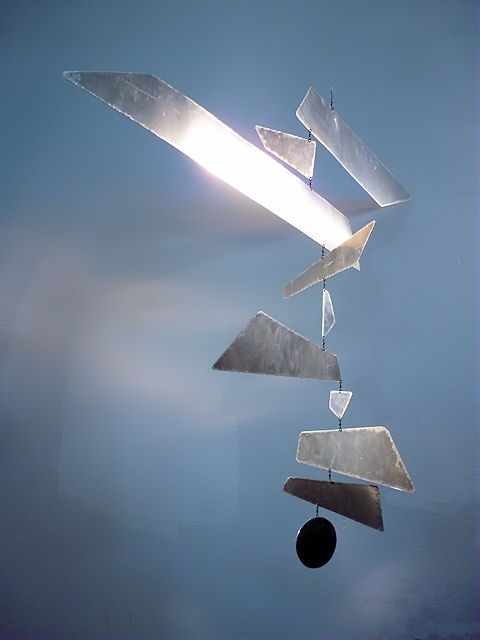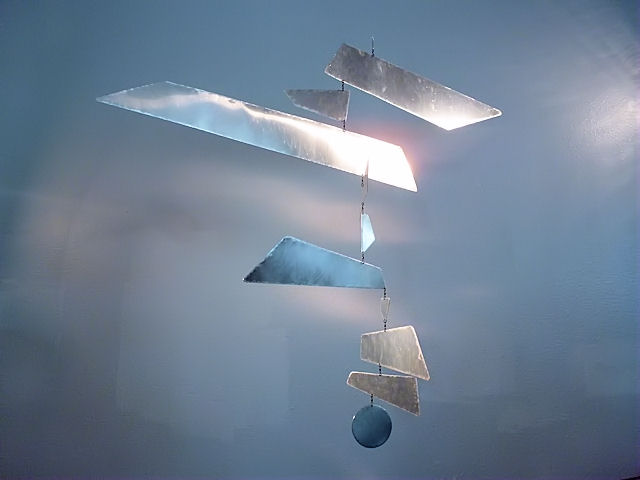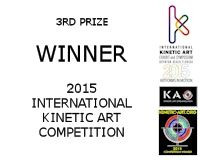Custom Hanging Mobile Sculpture and Mies van der Rohe Daybed
A custom designed mobile I made in 2012 with the modern classic Mies van der Rohe daybed (to illustrate the size of the mobile). It measures 5.5 feet in height and 4.5 feet width, made with steel (sheet metal, wire, rivets) and a solid lead metal weight:
This mobile became the original inspiration for the custom-made mobile I made for the movie The Upside released in 2019.
It seems to me that this mobile crosses over from a mid-century modern style to a more contemporary one, in one of my earlier ventures to break away from Alexander Calder‘s work and to expand the art form of mobiles that he created beyond his work, which eventually led to these contemporary mobile sculptures, this hypothesis and these much more complex and intricate mobile sculptures.
The mobile shown here moves beautifully with the air currents. Although originally not intended for outdoors, I suspended it in the yard for a while, and it proved strong enough to withstand an intense storm. The weight at the bottom provides for quite a bit of stability. It’s a kinetic mobile sculpture, but it would make for a sophisticated hanging wall sculpture as well. I still have a stack of drawings with mobiles similar to this one, based on the same idea or theme (bird like?). I may get around to turning those drawings into mobiles eventually.
It seems that Stephen H. Kawai may have felt inspired by this mobile with his Ghost Bird (2018).
– See more of my mobile sculptures –
Confused about the most expensive hanging mobile ever sold
I received an email the other day asking if I could make a reproduction of Calder‘s “Snow Flurry”, which I wouldn’t be allowed to do because all of his works are copyrighted. But it made me take a closer look at the mobile and I came across something that was rather confusing.
The “Snow Flurry” by Alexander Calder is the most expensive hanging mobile ever sold to date (May 2012), only surpassed by “Lily of Force” which is a stabile by Calder [Update: “Poisson volant (Flying Fish)“, a hanging mobile Calder made in 1957, sold for $25,925,000 on May 13th 2014, a new world auction record for Calder]. It realized a hammer price of US$10,386,500 at Christie’s Post-War and Contemporary Art Evening Sale at the Rockefeller Plaza, New York, on on May 8th 2012. Here’s a photo from the auction:
But here’s what confuses me about this. The following is the photo of “Snow Flurry” that Christie’s posted on their site. Count the elements on the mobile.
21 elements. Now, following is the photo of “Snow Flurry” that the Calder Foundation has on their site. Count the elements on that mobile, too.
30 elements. 9 elements more.
First I wondered if part (9 elements) of the “Snow Flurry” that the Calder Foundation has displayed maybe got lost or destroyed somehow, but then I noticed that besides the number of elements on each, if you pay close attention to the structure of each mobile you’ll realize, these are clearly two different mobiles.
My best guess would be that Calder made more than one hanging mobile with the same name. If that’s the case, I would be surprised that Christie’s wouldn’t be clarifying it in their description of the mobile.
The mobile sold came from Eliot Noyes‘ estate who was a friend of Calder’s.
I’ll post an update if I find out more.
Update: I received the following via email a couple of days ago from Jim in Portland, ME: “It appears that Calder made at least several numbered mobiles called Snow Flurry, all a little different. See this photo regarding the one at MoMA, which is identified as Snow Flurry I. There is one now at the Portland, ME Museum of Art (where I live), which is called Snow Flurry III. I presume the one that sold at auction in 2012, and which you mention in your original post, was a different Snow Flurry than either of these. I wonder how many of them he made? Snow Flurry III is really quite amazing in person.” Thanks, Jim!
__________
Here’s a beautiful video of the 21 element “Snow Flurry”:
New large hanging mobile – Mobile 92
Just finished making a 6 foot (2 meter) sheet metal version of this hanging mobile design (a bird?):
It looks amazing! And moves amazingly well too with the wind currents. I can’t wait to post photos of it, maybe a video, too. Not sure yet what would be the best place / background for pictures. A plain white simple space? A farm? Maybe a lake.
[Update: Image with Mies van der Rohe daybed]
Calder’s “Hello Allentown”, hanging mobile, for sale
[Update: Christie’s will have four Calder mobiles for sale on May 15th 2013]
Christie’s Post War and Contemporary Art Evening Auction on October 11th 2012 in London will include Alexander Calder‘s “Hello Allentown“, a hanging mobile he made the same year he passed away, 1976.
Expected to go for US$ 2 to 3 Million. More affordable options are here and here.
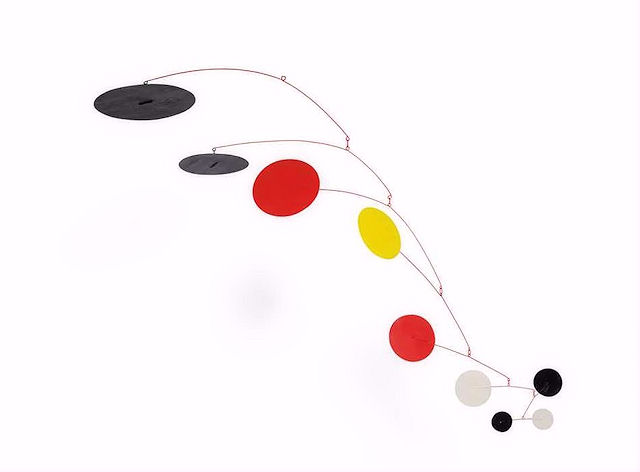
Before moving on to the Lot Notes, does anyone know if this quote is really by Calder: “The perpetually changing relations within the mobile gives them a metaphysical identity that relies on temporal memory to assemble the sequence of partial definitions comprising the more complex identity of the whole.”
Lot Notes: ‘The simplest forms in the universe are the sphere and the circle, I represent them by discs and then I vary them. My whole theory about art is the disparity that exists between form, masses and movement’ (A. Calder, quoted in K. Kuh, The Artist’s Voice: Talks with Seventeen Artists, New York, 1962).
Suspended from a sequence of bright red wires, the progression of multi-coloured discs that glides through the air is a triumphal example of Alexander Calder’s iconic mobile sculptures. Having once formed part of the historic collection of Philip and Muriel Berman and in fact titled after their hometown, Allentown, Pennsylvania, Hello Allentown is a tribute to the lifelong journey of collecting during which they amassed an impressive collection of monumental and important sculpture, paintings, drawings and prints. True civic leaders well known for their philanthropy as well as their commitment to championing the work of both young aspiring artists and the masters of their time, Philip and Muriel Berman collection was a testament to their personal connection with the art and in many instances their personal friendships with the artists, a friendship evident through the very title of Hello Allentown. With the artist signature aplomb, the vibrant spheres occupy both the vertical and horizontal planes, commanding the space in which they hang. The black discs that mark the highest and lowest point of Calder constellation act to contain the energetic eruptions of fiery reds and iridescent yellow that are contained within the centre of the configuration. Hello Allentown incorporates two of Calder favourite monikers – his exuberant use of colour and his formal examination of the spherical form. Through these two devices Calder investigates the formal relationship between two of the most basics tenets of art – form and colour – and how they interact, particularly in three-dimensional form. From the large black disc at the apex of the composition the eye is drawn down through a series of graceful arching limbs, each of which supports a round disc which decreases in size as the sculpture draws to a triumphal conclusion, ‘The simplest forms in the universe are the sphere and the circle Calder once said, ‘I represent them by discs and then I vary them. My whole theory about art is the disparity that exists between form, masses and movement’ (A. Calder, quoted in K. Kuh, The Artist’s Voice: Talks with Seventeen Artists, New York, 1962).
In addition to its elegantly balanced form, Hello Allentown is also distinguished by its chromatic range and intensity. Colour was an important expressive device for the artist and one of the most important factors in his compositions. For Calder, colour was not a representational force but rather an emotional one, in much the same way as Henri Matisse and André Derain, the historical pioneers in non-traditional use of colour. As Calder himself once commented: ”I want things to be differentiated. Black and white are first – then red is next. I often wish that I had been a Fauve in 1905” (A. Calder, quoted in Calder, London 2004, p. 89). Hello Allentown clearly demonstrates this philosophy with its harmonious use of black and white discs to compliment the chromatic brilliance of its red and yellow core.
Whilst Calder”s influential visit to Mondrian”s Parisian studio in 1930 is well documented as being the spark that ignited his interest in introducing colour and movement into sculpture, it is perhaps his friendship with Joan Miró that had the greatest influence on his career. The two men first met in 1928 and remained lifelong friends until Calder death in 1976. ”We became very good friends,” Calder once said, ”and attended may things together I came to love his painting, his colour, his personages” (A. Calder, quoted in E. Hutton and O. Wick (eds.), Calder, Miró, London 2004, p. 27). Their friendship was based on outsiders from the established art scene and reveled in their disdain of convention. From the early stages of their relationship, the pair explored the increasingly dominant field of abstraction – Calder prompted by his visit to Piet Mondrian”s atelier and Miró with his painterly forms that would eventually morph themselves into his iconic Constellations a few years later. The various coloured discs of Hello Allentown recall the lyrical, semi-abstracted forms of Miró paintings, a visual relationship that is emphasised by the fact that they held together by wires which resonate with the elegant sense of calligraphic line of the Spanish artist.
The present work is a rare example of a mobile that was produced during the latter part of Calder”s career. From the mid-1950s onwards Calder became increasingly concerned with making large-scale outdoor sculptures, making over three hundred monumental works that were placed in city plazas, corporate lobbies, airports and museum during the post-war building boom. It was through an incredible act of generosity and through their friendship with Calder that Philip and Muriel Berman, the renown first owners of Hello Allentown, provided the financing for Homage to Jerusalem-Stabile (1977), a work that would prove to be the last monumental sculpture planned by Calder but which he would not live to see installed on the site he chose on Jerusalem”s Holland Square. That Calder would return to his beloved mobiles during the final year of his life is testament to the importance in which he held this forms. As such, Hello Allentown represents the pinnacle of Calder”s approach to the prevailing march towards abstraction. Calder wanted to redefine the nature of art, and of sculpture in particular, by taking it off the wall and the pedestal and breathing movement into its static form. The resulting mobiles were his revolutionary response to these ideas of movement and colour and Hello Allentown is the superb result of Calder”s unfettered imagination and his unmatched technical skill as an engineer that enabled him to produce works that spring into life with the slightest breath of wind.

